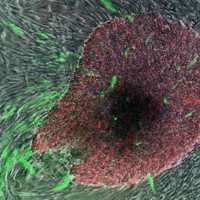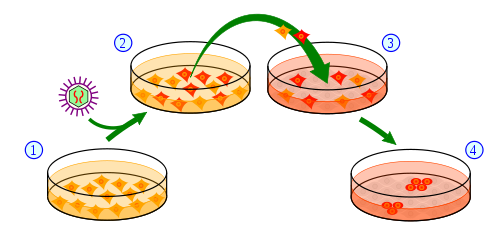
'Induced' stem cells make exciting advances
Stem cells from HD patients: becoming important tools for researchers – and now correcting the HD mutation in the lab

Stem cells are a source of great excitement for patients suffering from illnesses caused by the death of cells in the body – like Huntington’s disease. But the devil is in the details, and actually using these powerful cells to help HD patients is a complex problem. Now, two new studies have advanced stem cells as a tool for researchers, and prove that it is possible – in cells in a dish – to correct the mutation that causes HD.
Stem cell refresher
All humans started as a single fertilized egg, which repeatedly divides to form the approximately 50 trillion cells found in the adult human. Each cell has its own properties – muscle cells function very differently from skin cells, and so on. The special properties of each type of cell determine what functions that cell can perform.

Image credit: PNAS
For many years, scientists believed that only a very special type of cell – called a stem cell – was capable of dividing and giving rise to the different types of cells in our bodies. The most obvious source of these cells was early stage embryos, which is where they are normally found. While these ’embryonic stem cells’ were extremely powerful – allowing scientists to grow new cells like brain cells in the lab – their use was ethically and legally difficult because they required the destruction of embryos.
In 2006 everything we know about stem cells changed, when Shinya Yamanaka discovered the capability to ‘re-program’ any adult cell into a stem cell. Suddenly, there was no need to destroy embryos to create stem cells – we could simply take a small skin sample and re-program cells found in the skin to become stem cells. Scientists have become fairly good at growing neurons, muscle cells and other critical types of cells that are damaged in various diseases from stem cells, once they have them.
These reprogrammed cells are called induced pluripotent stem cells, or iPS cells.
Our stem cell primer previously reviewed the excitement and difficulties of stem cell research for Huntington’s disease.
Stem cells from HD patients
In a paper just published in the slightly oddly-named journal ‘Cell Stem Cell’, a collaborative group of scientists made and studied a set of these induced pluripotent stem cells from HD patients. The investigators were curious whether stem cells from HD patients would behave differently from those of people who don’t carry the mutation.
The group of scientists looked at how the cells behaved in the lab. Several decades of work has suggested that cells from HD patients are abnormal, but no one has ever been able to study stem cells in this level of detail before, because they have been so difficult to obtain.
It turns out that the new stem cell lines created from Huntington’s disease patients do act differently from stem cells created from people without HD. The main differences were how the cells turned genes on and off and how they made energy.
These cellular symptoms largely match the observations scientists have made in other types of cells with the Huntington’s disease mutation, suggesting that these new stem cells will be a really useful tool to understand how the mutation alters the function of cells, eventually leading to their early death in HD.
What is the point of this? What can Huntington’s disease patients expect from these new cell lines? The most important contribution of HD patient stem cells is the provision of a model for scientists studying the disease.
Imagine you’re a drug company that believes that your new drug will help cells cope with the Huntington’s disease mutation and stay healthy longer. Now, thanks to these new stem cells, you can test your drug in brain cells made from actual HD patients, rather than cells from a mouse or a worm. Hopefully this will provide much more accurate results – and help us only test really effective drugs in people.
Cell replacement?
A dream for many researchers, and people living with Huntington’s disease – is that we could some day replace lost cells with new ones – allowing us to halt, or maybe even reverse, symptoms of degenerative diseases.
Growing new cells to replace those lost in a disease is known as cell replacement therapy, and it’s one of the reasons for all the excitement around stem cells. Some researchers believe that transplanting stem cells into the damaged parts of the brain of HD patients could replace those cells that die during the course of the disease.
Major scientific challenges will need to be conquered before cell replacement therapy could work. First, what cells should we put into people’s brains? Obviously, we’d like to replace the dying brain cells with more brain cells, not skin cells or muscle cells. So where do we get more brain cells, and how do we make sure they’re a genetic ‘match’ for the patient?
This is where these new ‘induced’ stem cells come in; for the first time we could theoretically take a skin sample from an HD patient, reprogram the cells to become stem cells or neurons, and inject those stem cells into the patient’s own brain. If it worked, this would be a fantastic option because the cells would be an exact genetic match to the patient.

Recent experiments using a rat suggests that stem cells injected in this way can form new brain cells that seem to integrate into the brain and help rats recover from brain damage.
Correcting the HD mutation
Sharp-eyed readers may have noticed a problem here – the mutation that causes HD is found in every cell of our body, including our skin cells and any stem cells we make from them. So, even if we successfully tackle the technical challenges of delivering stem cells into the brain, we’re stuck with new neurons that have the same mutation that causes HD in the first place!
The ideal solution for this problem would be if we could ‘fix’ the stem cells from HD patients by removing the mutation that causes HD, while the cells were growing in a dish. There are some very new techniques for doing just this – we’ve previously covered one technology, called zinc finger nucleases. But these technologies are new, and likely many years away from application in HD patients.
A group of scientists led by Lisa Ellerby at the Buck Institute for Research on Aging considered another approach to this problem. Making precise changes to the genes of stem cells growing in a dish is much, much easier than changing the DNA of living people. In fact, the process is routinely used to make the genetically-modified mice used to study biology and medicine in labs around the world.
Ellerby’s group did a very simple experiment – they gave stem cells from a Huntington’s disease patient a bit of extra DNA that told them how to make a normal, rather than mutant, HD gene.
The efficiency of this procedure is extremely low: of 5 million treated cells, only 2 cells used the extra DNA to make the appropriate correction. But by using a glowing marker to label those cells that actually made the correction, they could be isolated and grown.
This simple genetic trick enabled Ellerby and her group to make an amazing set of comparisons. They could ask questions like, what is the difference between a cell with an HD mutation, and the exact same cell with the mutation corrected? Her team, like the stem cell consortium, looked to the decades of work on HD in cells and investigated what happened to HD cells that were ‘repaired’. This analysis revealed that some of the abnormalities in HD cells can be corrected by repairing the HD mutation.
Problem solved?
This provides important information to scientists studying Huntington’s disease. But it might be just as important for solving the treatment problem: how do we get new cells to be suitable for replacing lost cells in HD?
Coming back to this problem now, we can see that it is now possible, in theory, to reprogram skin cells from an HD patient into stem cells. Those stem cells could then be genetically ‘corrected’, removing the mutation that causes HD from their genome. Implantation of those genetically modified cells would, in theory, allow new neurons to grow in the patients brain, free of the HD mutation.
Here at HDBuzz, we’re pleased at the speed of these advances in stem cells, and the possibilities for HD treatments. But we also consider that developing these remarkable leaps into treatments for HD will still be a very long and difficult process – in fact, much more difficult than developing a traditional drug.
Delivering genetically modified cells into the brains of living patients is very risky, and will have to be approached with great caution. There are likely many years of increasingly sophisticated laboratory trials that need to be conducted before this treatment method is used on a large scale in people.
On a much shorter timeframe, though, these important advances in iPS cells are likely to be very useful tools for understanding Huntington’s disease and streamlining the drug development process. Meanwhile, stem cells as treatments are moving slowly along the pipeline of therapies in development for HD. As other treatments with shorter time frames go through trials, it’s critical to begin development on these longer term but extremely promising, technologies.
Learn more
Sources & References
For more information about our disclosure policy see our FAQ…


